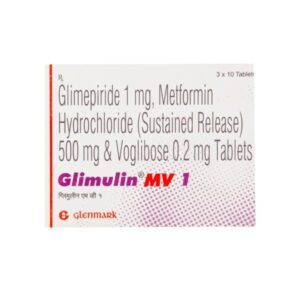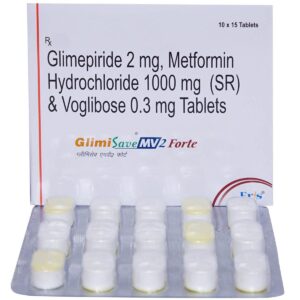METFORMIN + GLIMEPRIDE + VOGLIBOSE
Metformin: Metformin is a medication commonly prescribed to manage type 2 diabetes mellitus. It belongs to the class of drugs known as biguanides. Metformin helps lower blood glucose levels by reducing the amount of glucose produced in the liver and improving insulin sensitivity in muscle and fat cells.
The primary use of metformin is to control blood sugar levels in individuals with type 2 diabetes. It is often prescribed alongside lifestyle changes such as a healthy diet and exercise. Metformin may also be used in combination with other diabetes medications or insulin.
The typical starting dose of metformin is usually 500 mg or 850 mg once daily, with meals. The dosage may be gradually increased by the healthcare provider, depending on the individual’s response and blood sugar levels. The maximum daily dose is typically 2000-2500 mg, divided into two or three doses.
Common side effects of metformin include gastrointestinal effects such as nausea, diarrhea, and abdominal discomfort. These side effects may be reduced by taking the medication with meals or by starting with a low dose and gradually increasing it. It is important to inform a healthcare provider if these side effects persist or become severe.
In rare cases, metformin can cause a serious condition called lactic acidosis. This is more likely to occur in individuals with reduced kidney function or other underlying medical conditions. Symptoms of lactic acidosis include weakness, fatigue, muscle pain, trouble breathing, and irregular heartbeat. If these symptoms occur, medical attention should be sought immediately.
Other less common side effects of metformin may include vitamin B12 deficiency, metallic taste in the mouth, and changes in taste sensation. It is advisable to discuss any concerns or potential side effects with a healthcare provider before starting metformin.
Glimepride: Glimepride is a medication that is used to treat type 2 diabetes. It belongs to a class of drugs called sulfonylureas, which work by stimulating the pancreas to produce and release more insulin. Insulin is a hormone that helps regulate blood sugar levels.
The primary use of Glimepride is to help lower blood sugar levels in people with type 2 diabetes. It is often prescribed alongside other diabetes medications, such as metformin, or as a single therapy for patients who cannot tolerate metformin.
The mechanism of action of Glimepride involves binding to a specific receptor on the pancreatic beta cells, which stimulates the release of insulin. This helps to improve the body’s ability to use insulin effectively and control blood sugar levels.
The dose of Glimepride can vary depending on individual factors such as age, weight, and overall health. It is typically taken once a day with breakfast or the first main meal of the day. The starting dose is usually 1-2 mg, and it can be increased gradually over time if needed. However, the maximum recommended daily dose is 8 mg.
Common side effects of Glimepride may include low blood sugar (hypoglycemia), which can cause symptoms such as weakness, dizziness, sweating, shakiness, and confusion. Other side effects may include nausea, upset stomach, headache, weight gain, and allergic reactions.
It is important to note that Glimepride is not suitable for everyone, and the medication should be used under the guidance of a healthcare professional. It may interact with other medications or medical conditions, and the dosage may need to be adjusted accordingly.
In summary, Glimepride is a drug used to treat type 2 diabetes by stimulating insulin secretion from the pancreas. It helps to lower blood sugar levels and can be used as a single therapy or in combination with other diabetes medications. The dose and administration should be determined by a healthcare professional, and common side effects include hypoglycemia, nausea, and weight gain.
Voglibose: Voglibose is an oral antidiabetic drug that is primarily used for the treatment of type 2 diabetes mellitus. It belongs to a class of medications known as alpha-glucosidase inhibitors.
Mechanism of action:
Voglibose works by inhibiting a specific enzyme called alpha-glucosidase in the small intestine. This enzyme is responsible for breaking down complex carbohydrates into simple sugars, which are then absorbed in the body. By inhibiting this enzyme, voglibose slows down the digestion and absorption of carbohydrates, leading to a delayed rise in blood sugar levels after meals.
Use:
Voglibose is typically used in combination with diet and exercise to help manage and control blood sugar levels in patients with type 2 diabetes. It is especially useful for individuals who experience postprandial hyperglycemia (high blood sugar levels after meals).
Dose:
The recommended starting dose of voglibose is usually 0.2 mg, taken orally three times daily before meals. However, the dosage may vary depending on individual patient factors and should be determined by a healthcare professional. It is important to follow the prescribed dosage instructions carefully.
Side effects:
Like any medication, voglibose can have several side effects. The most common side effects include flatulence (excessive gas), diarrhea, abdominal discomfort, and bloating due to its mechanism of action. These side effects are generally mild and temporary. However, in rare cases, more severe side effects such as liver dysfunction, skin reactions, and allergic reactions may occur. It is important to report any unexpected or concerning side effects to a healthcare professional.
Overall, voglibose is an effective antidiabetic drug that helps control blood sugar levels by delaying the absorption of carbohydrates. However, it is important to use the medication under the guidance of a healthcare professional and to follow a proper diet and exercise regimen for optimal results.



